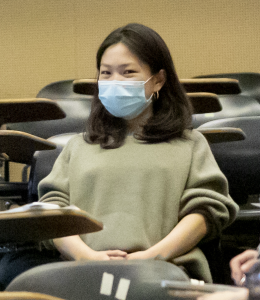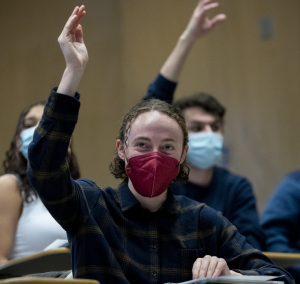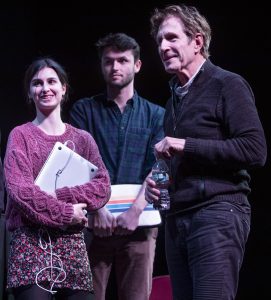By Will Holland (BFF 2019, Bates Class of 2020)
The collective body of the audience is the foundation upon which a successful film festival is built. The audience creates the demand and popularity for such events to occur, as well as fiscal income from ticket sales and leveraged attendance for sponsorships. Without audience attendance, there would be no demand for film festivals. Because the Bates Film Festival is funded by different organizations and departments within the college, the event is independent of audience support for financial survival. Financial independence affords the festival programming and event flexibility other film festivals cannot enjoy, but the event still has to program material that will inspire audience engagement and attendance to make the festival worthwhile. The Bates Film Festival draws on attendance from both the local Lewiston-Auburn and wider Maine communities, as well as the Bates College student, faculty, and staff population. A pertinent narrative to Bates students as well as the Lewiston population is social justice, in addition to empowering cinematic perspectives from disenfranchised populations. Bates students have a tradition of interest in social justice, while the presence of Somali refugees has been a dominant narrative of Lewiston-Auburn throughout the twenty first century. Showcasing films that engage social justice and justice for immigrant communities engages topics significant to the Bates and Lewiston-Auburn communities. While promoting social advocacy is important on the screen, it is also attainable in coordinating the festival. As many screenings as possible were shown with subtitles in venues with accessibility to all people, free of charge, to afford the opportunity to attend the festival to the community at large. Programming films as well as structuring the audience experience around the foundational festival narrative of social justice increased the popularity and participation of the Bates Film Festival.
“As many screenings as possible were shown with subtitles in venues with accessibility to all people, free of charge, to afford the opportunity to attend the festival to the community at large.“
The films showcased in the Film Festival were selected from filmmakers of diverse backgrounds that addressed a spectrum of social concerns. The films addressed topics such as gentrification in The Last Black Man in San Francisco, gender relations in short films, as well as LGBTQ+ rights in Changing the Game, which engage material from a wide variety of academic departments, including those that sponsored the event. The spectrum of social justice topics addressed in the films engage different aspects of the Bates population, which thus proliferates audience engagement. Many of the films, such as A Shared Space: Lewiston, Midnight Traveler, and Tazekka, address immigrants and diasporic populations. This showcase of immigration undoubtedly appeals to one of the more significant social topics of the Lewiston-Auburn community, the development of the Somali refugee population. Showcasing films that address the narrative of immigration engages the local community through its consultation of a significant local social topic. While these films relate to the audience and are of interest, they do not merely appeal because of familiarity. The films address challenges and interests of the audience that catalyze engaged conversation. Showcasing films of personal and academic interest to audience members increases general engagement in the event.
“The festival was promoted to local community members to increase the diversity of opinions and open the event to people beyond the Bates population.”

The social justice narrative was also manifested in structuring the audience experience to emphasize accessibility. The festival aspires to engage “the transformative power of our differences,” as articulated in the Bates College and Film Festival mission statements. In order to engage the transformative power of difference, we programmers sought to open the festival to as diverse an audience as possible, attained by eliminating any feasible attendance obstacles. The festival was promoted to local community members to increase the diversity of opinions and open the event to people beyond the Bates population. Funding was sourced from different organizations within the College which allowed admission to be free of charge, eliminating fiscal constraints on attendance for all viewers. All films were also screened in rooms with disability accessibility and subtitles if available. While the subtitles may have threatened the artistry of the films, they opened the opportunity of attendance to those who may previously have been excluded. By providing accessibility to as many members of the Bates and Lewiston-Auburn communities as possible, audience engagement and participation in the festival was maximized.

Daniel Dayan analysed the festival audience as a cohesive body in his text, “Looking for Sundance. The Social Construction of a Film Festival.” Dayan evaluated the audience at the Sundance Film Festival to identify the behavioral rules that determined audience interaction and their expectations of the event (Dayan, 2000, 45). Like any social performance, a film festival is dictated by cultural norms that define both the expectations the audience has for the event, and behavior during the function (Dayan, 2000, 45). The expected audience behavior includes the ability to engage in debate concerning the aesthetic and political choices of a given work (Dayan, 2000, 46). While the Bates Film Festival audience comprised of Bates students and local community members may have differing ability to critically analyze a film, they undoubtedly have the capacity to engage in lively discussion concerning the political and ideological choices made to depict social justice topics closely related to them. Because the topics addressed in the films are of personal and educational interest to the Bates and local community, the audience engagement and participation in the festival is more lively, consistent with the behavioral norms of film festival audiences. This capacity to engage in discussion is only furthered when access to the festival is provided to a diverse community who normally may be unable to attend due to accessibility and financial restraints. Consistent with Dayan’s expected festival audience behavior, the Bates Film Festival audience was engaged with the selected social justice topics related to them.
The social justice narrative of the Bates Film Festival, manifested in the programming selections and coordination of the event, promoted audience attendance and participation. The films, sourced from diverse directors addressing a spectrum of social topics, appealed to the academic and social interest of the Bates population, as well as recent developments in the local community. The event was structured to eliminate any attendance obstacles to create a diverse audience that would catalyze inspired and informed discussion about the social justice topics programmed in the films. The commitment to the guiding festival ideology of social justice in the planning and execution of the event fostered a diverse audience of engaged individuals interacting with the spectrum of program topics.
Works Cited
Dayan, Daniel. “Looking for Sundance. The Social Construction of a Film Festival.” The Film Festival Reader, edited by Dina Iordanova, St Andrews Film Studies, 2013, pp. 45-58.






